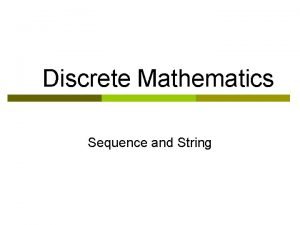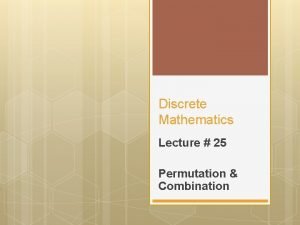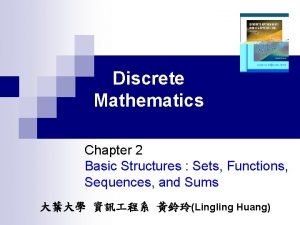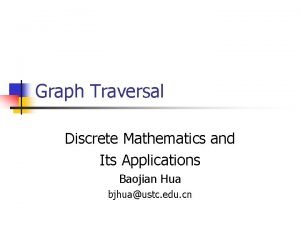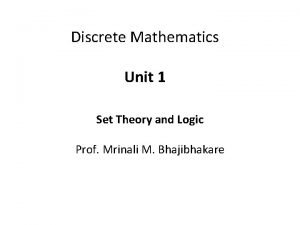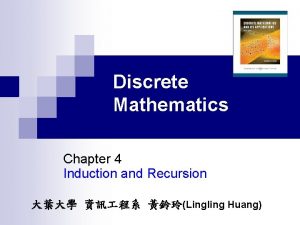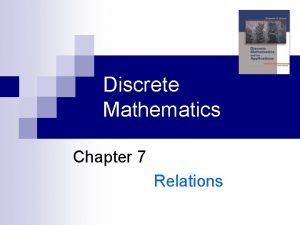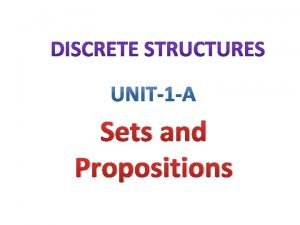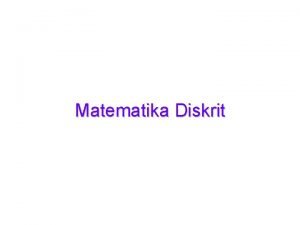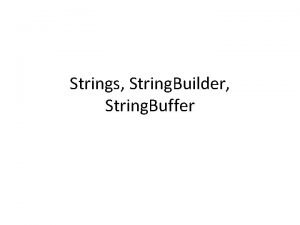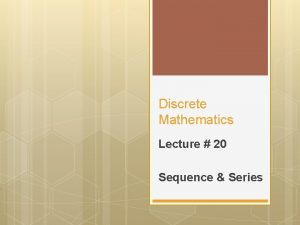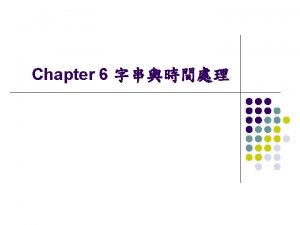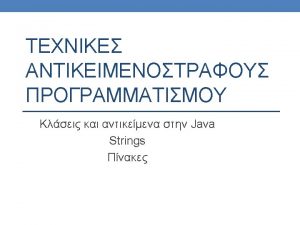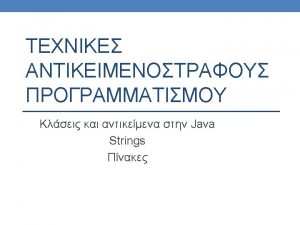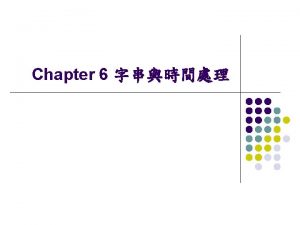Discrete Mathematics Sequence and String Sequences and strings









- Slides: 9

Discrete Mathematics Sequence and String

Sequences and strings A sequence is an ordered list of numbers, usually defined according to a formula: sn = a function of n = 1, 2, 3, . . . p If s is a sequence {sn| n = 1, 2, 3, …}, p n n n p s 1 denotes the first element, s 2 the second element, … sn the nth element… {n} is called the indexing set of the sequence. Usually the indexing set is N (natural numbers) or an infinite subset of N.

Examples of sequences Examples: 1. Let s = {sn} be the sequence defined by sn = 1/n , for n = 1, 2, 3, … The first few elements of the sequence are: 1, ½, 1/3, ¼, 1/5, 1/6, … 2. Let s = {sn} be the sequence defined by sn = n 2 + 1, for n = 1, 2, 3, … The first few elements of s are: 2, 5, 10, 17, 26, 37, 50, …

Increasing and decreasing A sequence s = {sn} is said to be n n increasing if sn < sn+1 decreasing is sn > sn+1, for every n = 1, 2, 3, … Examples: n Sn = 4 – 2 n, n = 1, 2, 3, … is decreasing: 2, 0, -2, -4, -6, … n Sn = 2 n -1, n = 1, 2, 3, … is increasing: 1, 3, 5, 7, 9, …

Subsequences A subsequence of a sequence s = {sn} is a sequence t = {tn} that consists of certain elements of s retained in the original order they had in s n Example: let s = {sn = n | n = 1, 2, 3, …} p n 1, 2, 3, 4, 5, 6, 7, 8, … Let t = {tn = 2 n | n = 1, 2, 3, …} 2, 4, 6, 8, 10, 12, 14, 16, … p t is a subsequence of s p

Sigma notation If {an} is a sequence, then the sum m ak = a 1 + a 2 + … + a m k =1 This is called the “sigma notation”, where the Greek letter indicates a sum of terms from the sequence

Pi notation If {an} is a sequence, then the product m ak = a 1 a 2…am k=1 This is called the “pi notation”, where the Greek letter indicates a product of terms of the sequence

Strings p Let X be a nonempty set. A string over X is a finite sequence of elements from X. n n p Example: if X = {a, b, c} Then = bbaccc is a string over X Notation: bbaccc = b 2 ac 3 The length of a string is the number of elements of and is denoted by | |. If = b 2 ac 3 then | | = 6. The null string is the string with no elements and is denoted by the Greek letter (lambda). It has length zero.

More on strings Let X* = {all strings over X including } p Let X+ = X* - { }, the set of all non-null strings p Concatenation of two strings and is the operation on strings consisting of writing followed by to produce a new string p n Example: = bbaccc and = caaba, then = bbaccccaaba = b 2 ac 4 a 2 ba Clearly, | | = | | + | |
 Sequences discrete math
Sequences discrete math Http protocol description
Http protocol description Permutation and combination in discrete mathematics
Permutation and combination in discrete mathematics Sets and functions in discrete mathematics
Sets and functions in discrete mathematics Tree traversal in discrete mathematics
Tree traversal in discrete mathematics Idempotent law truth table
Idempotent law truth table Induction and recursion discrete mathematics
Induction and recursion discrete mathematics Antisymmetric closure
Antisymmetric closure Sets and propositions
Sets and propositions Kenneth rosen discrete mathematics pdf
Kenneth rosen discrete mathematics pdf
